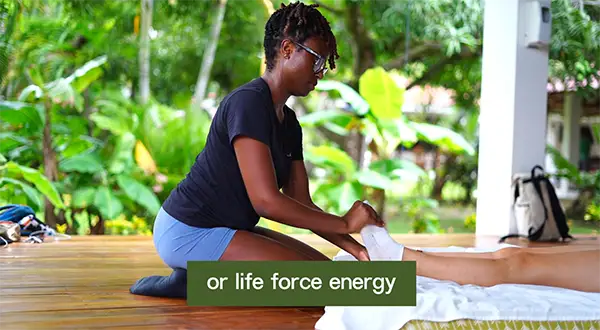How to Advance Your Career with an Asian Modalities Certification

Since more than 200 million Americans are affected by physical tension and other manifestations of stress, health and wellness careers are on the rise. Along with personal trainers and nutritionists, massage therapists are thriving as a result of today’s top health and wellness trends.
For example, ancient medicinal principles and practices, with traditions rooted throughout East Asia, have become increasingly popular. Yin yoga, acupressure, and ayurveda are all Asian healing modalities currently trending in massage therapy. While these have commonly been niche holistic bodywork techniques, more and more practitioners are expanding their focus to keep up with today’s trends.
If you’re interested in this massage therapy modality but don’t know where to start, here's an overview of what Asian modalities are, the benefits you can expect from obtaining a certification, and how you can begin your continued education journey in massage therapy.
What Is Asian Bodywork Therapy?
Asian Bodywork Therapy (ABT) are therapeutic pressure and manipulation techniques that incorporate principles of traditional Asian medicine. ABT aims to promote, maintain, and restore physical, emotional, mental, and spiritual health via treatment of Qi and meridians.
Meridians are channels that Qi—or life force energy—flows. When there are imbalances, blockages, or deficiencies of Qi, these symptoms are often perceived as a sign of illness.
According to a study conducted by the Journal of Traditional Chinese Medical Sciences, the following signs are used to diagnose a Qi deficiency:
- Fatigue
- Weak pulse
- Shortness of breath
Outside of energetic imbalances and muscle tension, ABT can help aid:
- Musculo-skeletal conditions
- Migraines
- Sciatica
ABT treatments typically include touch, pressure, and holding of the body along meridian points (sometimes called tsubos) through fingers, elbows, knees, and non-invasive instruments.
Leveraging Asian modalities in massage therapy is very different compared to other techniques because of its emphasis on meridian manipulation. Massage therapists who use this method assess their patients’ energetic constitution before treatment to help determine how to efficiently balance the flow of Qi.
Asian Modality Massage Techniques
There are more than 15 different modalities of ABT with origins from China, Japan, Thailand, and Korea, such as TuiNa, Qigong, and cupping therapy.
These modalities have been around nearly as long as civilization, with Traditional Chinese Medicine (TCM) dating back over 3,000 years ago. For this reason, many Asian bodywork therapies are predominantly associated with TCM, although many other types of East Asian practices have shaped ABT as we know it.
Two common types of ABT include:
- Thai massage: Sometimes referred to as “Yoga Massage,” this Thailand-based technique compresses, presses, and stretches the body’s surface while in passive Yin yoga poses to promote lymphatic drainage and energy channel regulation.
- Shiatsu: This Japanese massage technique, known for acupressure on 360+ tsubo points, applies weight on the body’s surface to stimulate the circulatory, lymphatic, hormonal, and autonomic nervous systems.
Shiatsu is a very sought-after modality, perhaps due to the effective relief it delivers to the lumbar spine. According to the World Health Organization, lower back pain is the leading cause of disability worldwide. Thai massage is also prominent, coupled with the recent resurgence in the popularity of yoga which grew 64% in the past decade alone.
Asian Modalities Theories
Just as many Asian massage modalities share similar methodologies, they also overlap in theories and principles. Beyond Qi theory, there are two fundamental theories integral to practicing Asian modalities.
Yin Yang Theory
The Yin and Yang theory, on a basic level, encapsulates the idea that there are no definitive opposites, while what appears as opposite represents complementary, balanced energy. The duality and adaptability of the Yin Yang principle symbolize unification and can describe all known and observed processes.
This theory can be applied to health in the form of ABT. According to the National Library of Medicine, good health is achieved through balancing Yin and Yang, while illness results from an imbalance–similar to Qi theory.
There are believed to be eight principles of the theory: Yin and Yang, Interior and Exterior, Cold and Hot, and Deficiency and Excess. Since Yin and Yang energies are believed to exist in constant flux, imbalance and excess of one translates to an imbalance in the other.
Methods for addressing yin-yang imbalances include:
- Acupuncture
- Massage
- Shiatsu
- Herbal medicine
- Diet
- Lifestyle changes
Five Element Theory
The Five Element theory describes wood, fire, earth, metal, and water as the basic elements of the material world. Also referred to as the Five Phases, the Five Element theory establishes a relationship between the different elements in nature and the Qi that flows through it. For example, each behavior, emotion, and organ is assigned to a specific element. These elements are constantly changing and evolving within.
When applied to Asian massage modalities, this theory is used in client evaluation to better understand client’s composition and tendencies to develop the best treatment. During this kind of bodywork, it’s believed that the practitioner and the patient connect through Qi.
3 Benefits of Obtaining Asian Modalities Certification
Learning Asian modalities is a worthwhile endeavor if you’re looking to explore traditional, holistic approaches to bodywork therapy. Here is an overview of some of the benefits you can expect from earning certifications in Asian modalities.
1. Promotes Personal and Professional Development
ABT is interconnected with ancient theories and teachings centered around self-discovery, therefore learning Asian modalities can help both you and your clientele live more balanced lives.
Knowledge of these theories can help you better serve your clients for numerous reasons. The Five Element theory, for example, includes hundreds of correspondences with other parts of the natural world, which can produce powerful insights you can bring to your professional practice. This might translate into complimentary lifestyle/dietary advice or more targeted bodywork during therapy since different organs are associated with each of the five elements.
2. Provides a Holistic Framework
Obtaining your Asian modalities certification might mean studying a curriculum that closely aligns with your lifestyle. Since these ideologies are holistic in nature, seeking a certificate in Asian modalities is an excellent opportunity to practice bodywork that integrates the mind, body, and spirit philosophy.
This integration was once considered non-scientific and now has gained credibility within Western medicine, even being attributed to the remedy of certain idiopathic or psychosomatic disorders. With sweeping acceptance and additional authority promoting this methodology, more and more clients are seeking a treatment aligned with this approach.
Some practitioners might find Asian modalities’ underlying yin-yang adaptations as both a practical and dynamic framework to health. Some clients might gravitate toward providing the centering aspects of Shiatsu for example. However, nearly all Asian modalities can be a great alternative to clients with preferences against invasive treatments, disrobing, or lubricants—allowing clients to remain fully clothed.
3. Increases Pay Potential
According to the National Center for Complementary and Integrative Health, Americans spent more than $30 million out-of-pocket on complementary health approaches a little over five years ago— representing 9.2% of all out-of-pocket U.S. spending. Not only that, this figure is only expected to increase over the years.
Therefore, if your practice includes both western massage and Asian modalities, you widen your possible clientele and, in turn, your income potential in the market. This is largely because of the increased versatility your practice would provide for your clients, enriching the menu of services.
Take Your Professional Practice to the Next Level
Learning Asian modalities of massage therapy is advantageous for anyone–from massage therapists to those interested in studying ancient medicine. The skillset Asian modalities can offer is comprehensive and therefore, invaluable.
The Costa Rica School of Massage Therapy (CRSMT) offers a 100 hour Asian Modalities Certificate Program, including a Shiatsu and TCM course (60 hours) and a Thai Massage course (40 hours). These NCBTMB and CE Broker approved courses are a great fit for you if you want to maintain licensure or enrich your education.
To learn more about this rewarding program, contact an admissions counselor to find out if the program is right for you and your career goals.





.jpg?width=352&height=198&name=Thai%20Massage%20in%20Costa%20Rica%20(1).jpg)

.jpg?width=352&height=198&name=Zero%20Balancing%20Classroom%20Image%20(3).jpg)